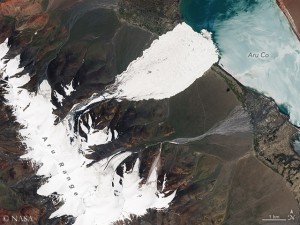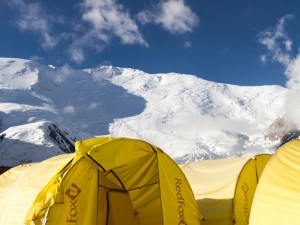When the glacier melts
Nepal has a problem with its glaciers. Over the past three decades, the 3808 glaciers in the Himalayan country have shrunk by about a quarter. The increased melt created some glacial lakes which scientists call ticking time bombs. One of the biggest of them, Tsho Rolpa, which is located about 100 kilometers northeast of Kathmandu, is estimated to contain between 90 and 100 million cubic meters of water by now. If the natural dam burst, it would have devastating consequences. This week, the Nepalese capital is hosting an international conference, during which more than 200 scientists from around the world exchange their findings about the impact of climate change on the high mountains of Asia – not only on the the Himalayas, but also on Karakoram, Hindu Kush, Tien Shan, Pamir and the Tibetan plateau.
Currently, more water …
Among the scientists in Kathmandu is the German Doris Duethmann. The hydrologist from the Helmholtz Centre Potsdam is researching the water balance at the upper reaches of the river Tarim. “The Tarim runoffs have been increasing sharply over the past 40 years because the higher temperatures led to a greater glacier melt”, the scientist told me (before leaving for Nepal). The Tarim is more than 2000 kilometers long and thus the longest river in Central Asia. It flows north of the Taklamakan Desert and is among others fed by glacier runoff of the Tien Shan mountains including the seven-thousanders Pik Pobedy (7439 meters) and Khan Tengri (7,010 meters). Especially the arid region at the edge of the Taklamakan is depending on the water from the mountains. In recent decades, the river Tarim has been increasingly tapped to irrigate fields. The strong glacier runoffs made it possible.
… later less
“People expect that it remains the way it is, but someday it will no longer be the case”, Duethmann predicts. “Now they are living from the increased glacier melt. This will not be permanent, because the melt drain the glaciers. In the northern Tien Shan the ice has declined by 30 percent compared with 30, 40 years ago.” In other words: There is less and less ice that can melt, and water will be short someday. It is difficult to reconcile the different interests, says the hydrologist. On the one hand there are countries on the upper course of the river like Kyrgyzstan and Tajikistan, who use the water of the mountains mainly to generate electricity, on the other hand countries on the lower course such as Uzbekistan and Turkmenistan, which draw much water to irrigate their fields. “The theme of water holds a lot of potential for conflict”, says Doris Duethmann. This makes it all the more important to talk to each other – as the scientists do now at the conference in Kathmandu.









